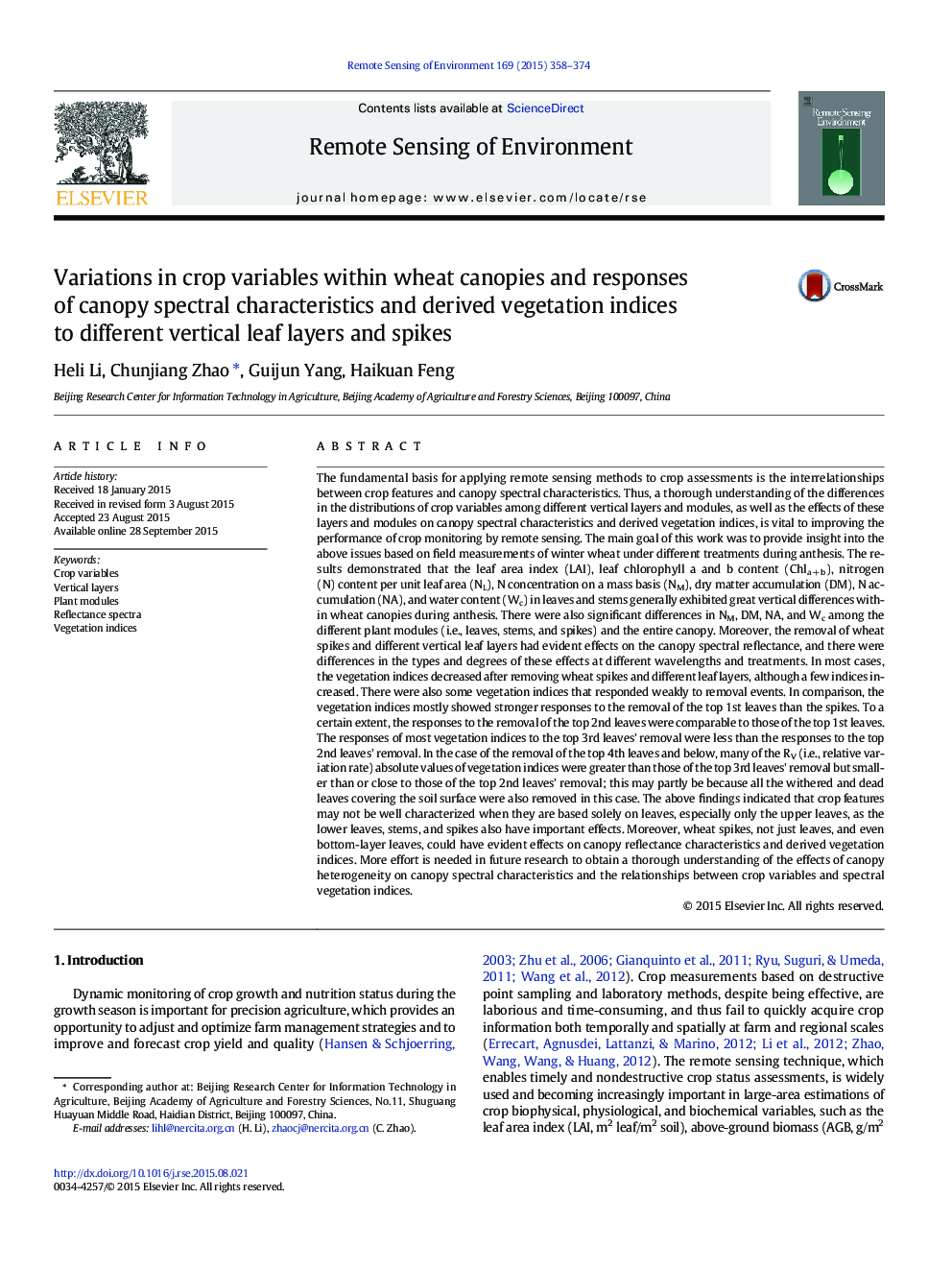| کد مقاله | کد نشریه | سال انتشار | مقاله انگلیسی | نسخه تمام متن |
|---|---|---|---|---|
| 6345845 | 1621231 | 2015 | 17 صفحه PDF | دانلود رایگان |
عنوان انگلیسی مقاله ISI
Variations in crop variables within wheat canopies and responses of canopy spectral characteristics and derived vegetation indices to different vertical leaf layers and spikes
ترجمه فارسی عنوان
تنوع در متغیرهای محصول درون سایبان گندم و پاسخ ویژگی های طوفان طناب و شاخص های پوشش گیاهی به لایه های مختلف عمودی برگ و خوشه ها
دانلود مقاله + سفارش ترجمه
دانلود مقاله ISI انگلیسی
رایگان برای ایرانیان
کلمات کلیدی
متغیرهای محصول، لایه عمودی، ماژول های گیاهی طیف بازتابی، شاخص های گیاهی
موضوعات مرتبط
مهندسی و علوم پایه
علوم زمین و سیارات
کامپیوتر در علوم زمین
چکیده انگلیسی
The fundamental basis for applying remote sensing methods to crop assessments is the interrelationships between crop features and canopy spectral characteristics. Thus, a thorough understanding of the differences in the distributions of crop variables among different vertical layers and modules, as well as the effects of these layers and modules on canopy spectral characteristics and derived vegetation indices, is vital to improving the performance of crop monitoring by remote sensing. The main goal of this work was to provide insight into the above issues based on field measurements of winter wheat under different treatments during anthesis. The results demonstrated that the leaf area index (LAI), leaf chlorophyll a and b content (Chla + b), nitrogen (N) content per unit leaf area (NL), N concentration on a mass basis (NM), dry matter accumulation (DM), N accumulation (NA), and water content (Wc) in leaves and stems generally exhibited great vertical differences within wheat canopies during anthesis. There were also significant differences in NM, DM, NA, and Wc among the different plant modules (i.e., leaves, stems, and spikes) and the entire canopy. Moreover, the removal of wheat spikes and different vertical leaf layers had evident effects on the canopy spectral reflectance, and there were differences in the types and degrees of these effects at different wavelengths and treatments. In most cases, the vegetation indices decreased after removing wheat spikes and different leaf layers, although a few indices increased. There were also some vegetation indices that responded weakly to removal events. In comparison, the vegetation indices mostly showed stronger responses to the removal of the top 1st leaves than the spikes. To a certain extent, the responses to the removal of the top 2nd leaves were comparable to those of the top 1st leaves. The responses of most vegetation indices to the top 3rd leaves' removal were less than the responses to the top 2nd leaves' removal. In the case of the removal of the top 4th leaves and below, many of the RV (i.e., relative variation rate) absolute values of vegetation indices were greater than those of the top 3rd leaves' removal but smaller than or close to those of the top 2nd leaves' removal; this may partly be because all the withered and dead leaves covering the soil surface were also removed in this case. The above findings indicated that crop features may not be well characterized when they are based solely on leaves, especially only the upper leaves, as the lower leaves, stems, and spikes also have important effects. Moreover, wheat spikes, not just leaves, and even bottom-layer leaves, could have evident effects on canopy reflectance characteristics and derived vegetation indices. More effort is needed in future research to obtain a thorough understanding of the effects of canopy heterogeneity on canopy spectral characteristics and the relationships between crop variables and spectral vegetation indices.
ناشر
Database: Elsevier - ScienceDirect (ساینس دایرکت)
Journal: Remote Sensing of Environment - Volume 169, November 2015, Pages 358-374
Journal: Remote Sensing of Environment - Volume 169, November 2015, Pages 358-374
نویسندگان
Heli Li, Chunjiang Zhao, Guijun Yang, Haikuan Feng,
